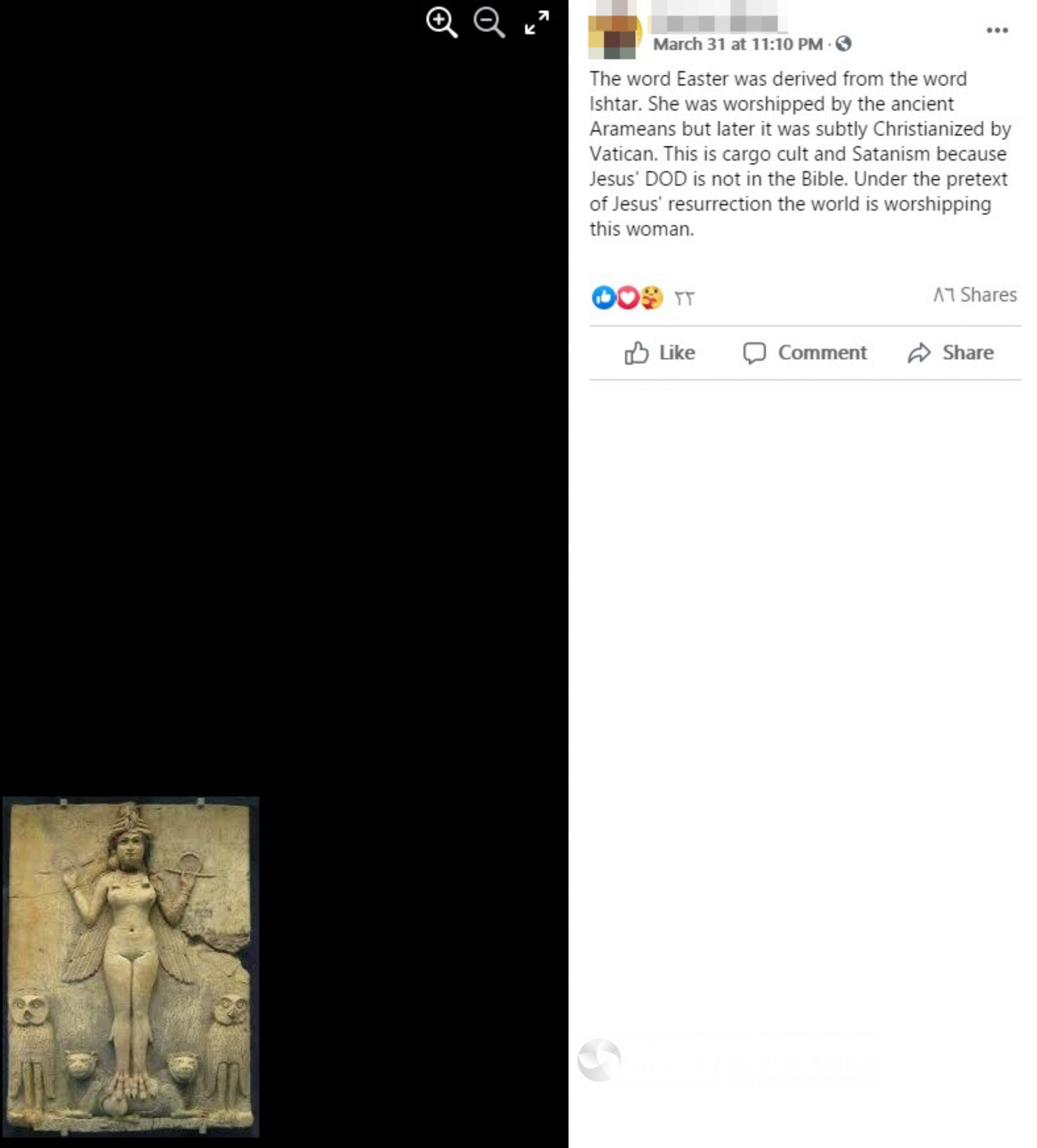The Statement
A Facebook post by a user in Papua New Guinea user has resurrected a claim that the name of the Christian festival Easter is derived from an ancient Mesopotamian goddess.
“The word Easter was derived from the word Ishtar,” the post says.
“She was worshipped by the ancient Arameans but later it was subtly Christianized by Vatican. This is cargo cult and Satanism because Jesus’ DOD is not in the Bible. Under the pretext of Jesus’ resurrection the world is worshipping this woman.”
Accompanying the post is an image of the Burney relief, otherwise known as the Queen of the Night, a fired clay figure excavated in southern Iraq and dated to the 19th-18th Century BC.
The April 1 post had generated more than 75 shares and 130,000 views at the time of writing. It’s just one example of a claim that has circulated for years; similar posts can be seen here and here.

The Analysis
The attempt to link Easter to the goddess Ishtar has circulated online since at least 2013, when a meme was posted to the Facebook page of the Richard Dawkins Foundation for Reason & Science, generating more than 220,000 shares. But the claim is much older, and is based on questionable historical methods.
According to the Encyclopaedia Britannica, Ishtar — an Akkadian name — was the Mesopotamian goddess of war and sexual love. In the Akkadian tradition, Ishtar is an astral deity associated with the planet Venus who delighted in bodily love and was also the “protectress of prostitutes and patroness of the ale house”. In the Sumerian tradition, Ishtar’s legacy was as a fertility figure, although she was also linked in myths to deaths and disaster.
Britannica addressed the post’s claim in a 2018 tweet: “No, Easter isn’t named after the Mesopotamian goddess Ishtar.”
The origin of that claim can be traced as far back as the 1853 book, The Two Babylons, written by Free Church of Scotland minister, the Rev Alexander Hislop. The book traced the practices of the Roman Catholic Church to pagan practices originating in ancient Babylon in order to show that the church is the “Whore of Babylon” as prophesied in Revelation 17.
At the beginning of Chapter III, Section II, he writes: “Then look at Easter. What means the term Easter itself? It is not a Christian name. It bears its Chaldean origin on its very forehead. Easter is nothing else than Astarte, one of the titles of Beltis, the queen of heaven, whose name, as pronounced by the people Nineveh, was evidently identical with that now in common use in this country. That name, as found by Layard on the Assyrian monuments, is Ishtar.”
The Assyrian monuments Hislop refers to are in the British Museum. One tablet, dating back to the 7th century BC, is inscribed with the legend of the Descent of Ishtar to the Underworld. It was discovered by archaeologist Sir Austen Henry Layard during excavations in Assyria between 1845 and 1851, just a few years before the publication of The Two Babylons.
Church historian and emeritus professor of history at Massey University in Auckland, Peter Lineham, told AAP FactCheck: “Hislop’s tendency was to think if it sounds the same it must be connected. That was the logic he used. It’s a wonderful book because it’s full of imagination and nonsense. It’s fantastic but utterly misconceived.”
In many countries, Easter is derived from the Jewish festival of Passover, known as Pesach in Hebrew. The word Easter is used only in the English-speaking world, while other cultures referred to it by words originating from the Latin and Greek word Pascha, referring to the Passover.
Experts have linked the timer of Easter to long-standing pagan celebrations of spring, noting that the same period later became associated with the resurrection of Christ with the rise of Christianity.
“For Easter in England, they used an existing festival, so the name comes certainly from a female goddess of England (Eostre). But there is zero connection with Ishtar,” Dr Lineham said.
Dr Bruce Forbes, a US author and religious studies scholar, also linked the English Easter tradition to Eostre, whose name appears in the writings of St Bede the Venerable. However, he told AAP FactCheck that this was based “totally on two sentences” from Bede in his book The Reckoning of Time from the eighth century.
“Here are the sentences: ‘Eosturmonath has a name which is now translated “Pascal month” and which was once called after a goddess of theirs named Eostre, in whose honour feasts were celebrated in that month. Now they designate that Pascal season by her name, calling the joys of the new rite by the time-honoured name of the old observance.’
“That is all the evidence we have. I understand Bede to be saying that the month in which English Christians were celebrating the resurrection of Jesus had been called Eosturmonath in Old English, referring to a goddess named Eostre. And even though Christians had begun affirming the Christian meaning of the celebration, they continued to use the name of the goddess to designate the season.”
Dr Forbes noted that Bede did not write that Eostre was a fertility goddess.
“What is most striking for me is that, as far as I know, there is no other evidence about such a goddess and celebration, not in other writings of the time, nor archaeological objects, no art, no carvings,” he said.
“Because of the lack of any corroborating evidence, some scholars are sceptical about the claim, but others find it credible, asking why a Christian monk would make up a non-Christian detail like this if it were not true.”
Several posts linking Ishtar to Easter have been widely debunked (see here, here and here).

The Verdict
There is no credible evidence that the term Easter was derived from the name of Ishtar, the goddess of love and fertility.
Experts told AAP FactCheck that linking Easter with Ishtar on the basis of pronunciation is based on flawed logic. Instead, the name has been traced to the name of the English goddess Eostre, although this is based solely on the records of Bede.
False – Content that has no basis in fact.
AAP FactCheck is an accredited member of the International Fact-Checking Network. To keep up with our latest fact checks, follow us on Facebook and Twitter.
All information, text and images included on the AAP Websites is for personal use only and may not be re-written, copied, re-sold or re-distributed, framed, linked, shared onto social media or otherwise used whether for compensation of any kind or not, unless you have the prior written permission of AAP. For more information, please refer to our standard terms and conditions.

















